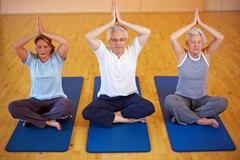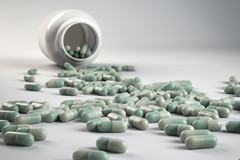
Tips to leverage neuroplasticity to maintain cognitive fitness as you age

Can white noise really help you sleep better?

Celiac disease: Exploring four myths

What is prostatitis and how is it treated?

What is Cushing syndrome?

Exercises to relieve joint pain

Think your child has ADHD? What your pediatrician can do

Foam roller: Could you benefit from this massage tool?

Stepping up activity if winter slowed you down

Common causes of cloudy urine
Harvard Health Blog
Read posts from experts at Harvard Health Publishing covering a variety of health topics and perspectives on medical news.
Articles
Medications most likely to put older Americans in the hospital
Some medications are well known for being risky, especially for older people. Certain antihistamines, barbiturates, muscle relaxants—take too much of them, or take them with certain other medications, and you can wind up in serious trouble (and possibly in the back of ambulance). But researchers from the federal Centers for Disease Control and Prevention (CDC) […]
Yoga may help feet, ease migraine
If exercise is good medicine, then yoga is, too. Research published recently suggests that yoga can be a useful therapy for lower back pain. An article in the November 2011 Harvard Health Letter indicates that yoga may also be a good way to keep feet strong and flexible, and so prevent falls. It can also help people who suffer from migraines. In The Migraine Solution, which will be published in January by Harvard Health Publishing and St. Martin’s Press, coauthor Paul B. Rizzoli, M.D., says that yoga can be a useful treatment for migraine because it is widely available, affordable, and very likely has benefits beyond migraine.
Avastin loses FDA approval for breast cancer
The FDA today revoked its 2008 approval of the drug Avastin to treat breast cancer, concluding that the drug does little to help women with breast cancer while putting them at risk for potentially life-threatening side effects. Avastin will remain on the market (and so be potentially available to women with breast cancer) because it has also been approved to treat other types of cancer.
Whole-body vibration doesn’t slow bone loss
Good vibrations may work for dancing on the beach or for romance, but they don’t seem to do much to strengthen bones. Results of a clinical trial published in the Annals of Internal Medicine showed that older women who stood on a vibrating platform for 20 minutes a day experienced just as much bone loss over the course of the year-long trial as women who didn’t use the platform.
The dangers of hospital delirium in older people
Many older people develop delirium when they are hospitalized. Delirium is a sudden change in mental status characterized by confusion, disorientation, altered states of consciousness (from hyperalert to unrousable), an inability to focus, and sometimes hallucinations. Hospital delirium is especially common among older people who’ve had surgeries such as hip replacement or heart surgery, or those who are in intensive care. Inflammation, infection, and medications can trigger hospital delirium as can potentially disorienting changes common to hospital stays, including sleep interruptions, unfamiliar surroundings, disruption of usual routines, separation from family and pets, and being without eyeglasses or dentures. Although delirium often recedes, it may have long-lasting aftereffects, including premature death and poorer outcomes, such as dementia and institutionalization.
Three reports to help with holiday health and emotional challenges
With Veterans Day and Halloween behind us, we are moving full steam ahead to the holidays, the stretch from Thanksgiving to New Year’s Day (or Super Bowl Sunday, depending on your perspective). The holidays can be a wonderful time, full of friends, family, and fun. But they can also generate pressures and situations that undermine health. To help you enjoy a healthy and happy holiday season, Harvard Health Publishing is offering three Special Health Reports that focus on common holiday challenges: depression, overuse of alcohol, and healthy eating.
Honor a veteran; understand PTSD
One of the challenges faced by many servicemen and servicewomen returning from war is post-traumatic stress disorder, or PTSD. This a lasting and exaggerated reaction to a terrifying or life-threatening event. It makes a person feel like he or she is living through the event over and over again. PTSD shows itself in three main ways: re-experiencing, avoidance, and arousal. Traumatic events can create memories that are stronger, more vivid, and more easily recalled than normal events. These haunting memories activate brain circuits that are responsible for instantly responding to potentially life-threatening situations. Good treatments are available for PTSD. A type of talk therapy known as cognitive-behavioral therapy appears to be the most effective. Antidepressants and other medications can also help.
Propofol: the drug that killed Michael Jackson
The manslaughter trial of Michael Jackson’s personal physician, Dr. Conrad Murray, focused a lot of attention on a powerful anesthetic agent called propofol. Propofol is sometimes called the “milk of anesthesia” because it comes in a white, oily solution. Propofol is used as an induction agent—the drug that causes loss of consciousness— for general anesthesia in major surgery. Propofol is also a very good anesthetic for milder sedation used for outpatient surgery because it puts people in a semi-conscious, drowsy state. It starts acting quickly, but also wears off quickly. Like many sedating anesthetics, propofol lowers blood pressure and suppresses breathing, so the heart function and breathing of patients need to be constantly monitored. With a lot of propofol around, opportunities exist for abuse, with possibly fatal consequences.
Managing fluids is one step toward better bladder control
As many as 32 million American women and men have some degree of incontinence—the unintended loss of urine or feces that is significant enough to make it difficult to do ordinary activities without frequent trips to the restroom. The most common causes of incontinence are childbirth and aging in women; prostate disorders and their treatment in men. Treatments include exercises to strengthen the pelvic floor, fluid management, medications, and surgery. For people with urinary incontinence, fluid management is an easy place to start, explains Better Bladder and Bowel Control, a new Special Health Report from Harvard Medical School. This involves drinking only when you are thirsty, limiting your fluid intake from all sources to six to eight 8-ounce cups of fluid per day from all sources, and minimizing caffeinated and carbonated drinks, as well as alcohol.
Fall back from daylight savings time may be good for the heart
Most Americans fall back from daylight savings 2011 during the wee hours of Sunday morning, November 6. Although the time change can be discombobulating, our hearts like it better than springing ahead. One study showed fewer heart attacks on the Monday after the end of daylight savings time in the fall; the opposite happens in the spring. Getting, or losing, that extra hour of sleep may explain the differences. Ways to ease into the time change include going to bed and waking up at the same time as usual, and getting some sunlight on Sunday as soon as you get out of bed.
Vitamin E may indeed increase the risk of prostate cancer
It was once thought that taking vitamin E could reduce the risk of prostate cancer. However, recent research suggests this is not the case. Back in 2008 one large study, known as the Selenium and Vitamin E Cancer Prevention Trial (SELECT), showed that not only did vitamin E fail to decrease the risk of prostate […]
Study supports alcohol, breast cancer link
A 28-year study of 106,000 women found that moderate alcohol slightly increases a woman’s risk of developing breast cancer. Women who had the equivalent of three to six drinks a week had a modest increase in their risk of breast cancer (15%) compared to women who never drank alcohol. That would translate into an extra 3 cases of breast cancer per 1,000 women per year. The risks were the same for wine, beer, and spirits. Because moderate drinking appears to prevent some types of heart disease—which affects more women than breast cancer does—it’s important for women to think about alcohol in light of their own personal health situation.
Pediatricians should ask teens about drug, alcohol use at every visit
Although current recommendations call for pediatricians to ask their adolescent patients about alcohol and drug use at every visit, many don’t. To make it easier for doctors and nurses to do this, the American Academy of Pediatrics has just published a set of questions to guide the confidential conversation, along with advice on what to do with the answers. The first question is a simple one about drug or alcohol use. If the answer is no, the health care provider should praise the teen and encourage him or her to continue making good decisions about health and safety. If the answer is yes, six follow-up questions called the CRAFFT questions) can help separate those who are experimenting from those who may be headed for serious trouble and need more in-depth help.
Yoga can help ease low back pain
Two new studies, one from the United Kingdom and one from Seattle, show that people with lower back pain may get some relief by regularly doing yoga. In the British study, yoga classes were more effective than standard care at improving “back function,” meaning it reduced back-related problems that interfered with everyday activities like walking, standing, climbing stairs, and so on. In the Seattle study, yoga was just as good as special stretching classes designed for people with low back pain. In the real world, it’s probably easier to find a yoga class than a stretching class designed specifically for low back pain. While yoga is generally safe, if you want to use it to treat something like low back pain, talk it over with your doctor first—in both studies, yoga made back pain worse for a small percentage of people.
A conversation with Dr. Jerry Avorn about drugs and the drug industry
The new fields of pharmacoepidemiology and pharmacoeconomics aim to understand how people use medications and how effective—or ineffective—medications are. A leader in this area is Dr. Jerry Avorn, chief of the Division of Pharmacoepidemiology and Pharmacoeconomics at Brigham and Women’s Hospital in Boston and professor of medicine at Harvard Medical School. In a recent issue of the Harvard Health Letter, editor Peter Wehrwein spoke with Avorn about generic drugs, the pharmaceutical industry, the high cost of cancer drugs, and more.
CDC panel says boys should get HPV vaccine, too
For the past five years, the Centers for Disease Control and Prevention (CDC) has recommended that all girls and young women be vaccinated against the human papillomavirus (HPV), a sexually transmitted virus that is a key cause of cervical cancer. Members of a CDC advisory panel have now voted unanimously that boys and young men should also get the vaccine. Vaccinating boys and young men against the virus will help prevent its transmission to women, and will also help prevent some of the 7,000 HPV-related cancers that occur in men each year, including cancers of the penis, anus, head, neck, and throat. HPV also causes genital warts in both men and women. The vaccine works best when a child gets it before he or she becomes sexually active.
Do chronic diseases have their origins in the womb?
Heart disease, stroke, diabetes, asthma, osteoporosis and other common chronic diseases are often blamed on genes, pollution, or the wear and tear caused by personal choices like a poor diet, smoking, or too little exercise. An intriguing hypothesis is that these and other conditions stem from a developing baby’s environment, mainly the womb and the placenta. During the first thousand days of development, from conception to age 2, the body’s tissues, organs, and systems are exquisitely sensitive to conditions in their environment during various windows of time. A lack of nutrients or an overabundance of them during these windows, so the thinking goes, programs a child’s development and sets the stage for health or disease.
Astounding increase in antidepressant use by Americans
Americans are taking antidepressants in astounding numbers. According to a report released yesterday by the National Center for Health Statistics (NCHS), the rate of antidepressant use in this country among teens and adults (people ages 12 and older) increased by almost 400% from the early 1990s to the mid 2000s. The federal government’s health statisticians figure that about one in every 10 Americans takes an antidepressant. Antidepressants were the third most common prescription medication taken by Americans in the study period. Antidepressant use was higher in women than men, and in whites than blacks or Hispanics.
Eat your way to a healthy heart
Your kitchen cabinets—along with your pantry, refrigerator, and grocery list—are probably more important than your medicine cabinet for maintaining or improving your heart’s health. That’s because what you eat influences many of the things that contribute to heart disease, including high blood pressure, high cholesterol, diabetes, inflammation, and electrical instability and function of the heart. The foods you choose can make these factors better, or worse. Healthy Eating for a Healthy Heart, a newly revised Special Health Report from Harvard Health Publishing, details a heart-healthy eating plan that you can follow for the rest of your life—while still enjoying the foods you eat. Some of the best choices include fish, vegetables, and whole grains. Healthy Eating for a Healthy Heart also includes 39 recipes of healthy, delicious, and easy-to-make foods.
A once (and future) meditator tries the relaxation response for stress
Thirty-five years ago, Dr. Herbert Benson defined and tested the relaxation response. This simple method for quieting brain activity slows the body’s processes and induces a feeling of well-being. Both have measurably positive effects on disorders caused by stress or made worse by it, including high blood pressure, abnormal heart rhythms, and many digestive disorders. In a recent lecture at Harvard Medical School, Dr. Benson described the technique and talked a crowd through it. Inducing the relaxation response is simple: Sit in a quiet place with your eyes closed. Relax your muscles and silently repeat a word, phrase, sound, or short prayer of your choosing over and over. When stray thoughts interfere (as they will), let them come and go and return to your word, phrase, or sound. Doing this daily can help ease stress.
Harvard experts weigh in on PSA test debate
For the first time, the U.S. Preventive Services Task Force recommends that healthy men avoid getting regular prostate cancer screening tests. The new recommendation, which conflicts with existing recommendations from the American Urological Association, has sparked controversy among experts and confusion among patients. Harvard’s Ann MacDonald, Editor of the Annual Report on Prostate Diseases, offers […]

Tips to leverage neuroplasticity to maintain cognitive fitness as you age

Can white noise really help you sleep better?

Celiac disease: Exploring four myths

What is prostatitis and how is it treated?

What is Cushing syndrome?

Exercises to relieve joint pain

Think your child has ADHD? What your pediatrician can do

Foam roller: Could you benefit from this massage tool?

Stepping up activity if winter slowed you down

Common causes of cloudy urine
Free Healthbeat Signup
Get the latest in health news delivered to your inbox!
Sign Up


















